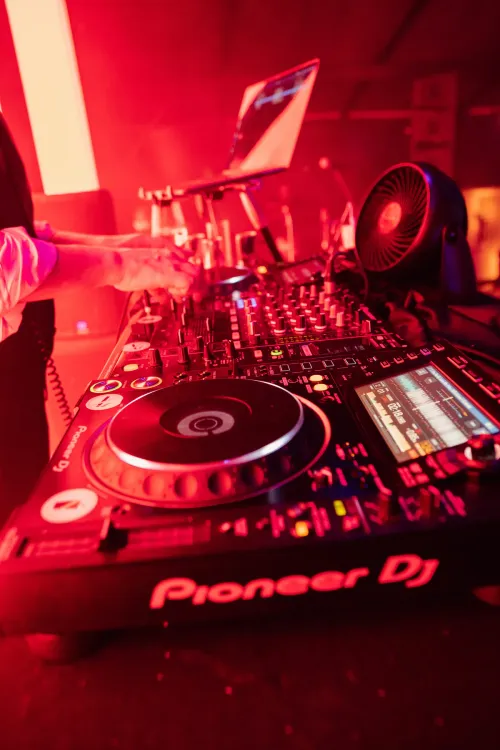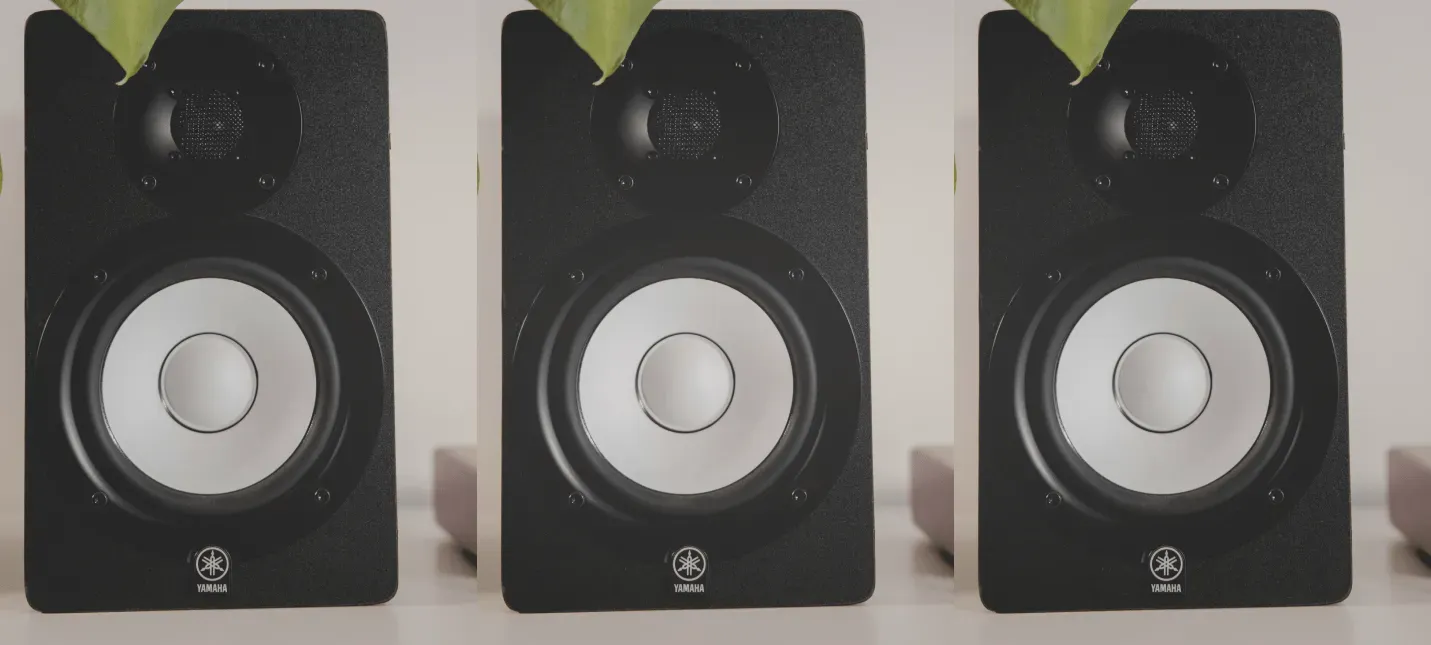Choosing between active and passive studio monitors is crucial in music production because it significantly impacts the accuracy of sound reproduction and overall workflow efficiency. Understanding the differences will help you make an informed decision that suits your needs and budget.
What are Active Speakers?
An active speaker is a loudspeaker that has a built-in amplifier.
Technical Make-up of Active Speakers
Active speakers contain all the necessary components to produce sound within a single unit. This includes the driver (which produces the sound), the crossover network (which directs specific frequency ranges to the appropriate drivers), and the built-in amplifier. The amplifier is specifically matched to the speaker's components, ensuring optimal performance and sound quality.
In active monitors, each driver (e.g., woofer, tweeter) often has its own dedicated amplifier, allowing for more precise control over the sound. The crossover network, being active, operates before amplification, ensuring that each driver only receives the frequencies it is designed to handle. This design minimizes distortion and maximizes efficiency.
Benefits of Active Speakers for Music Production
- Integrated amplification. Active monitors eliminate the need for an external amplifier, reducing setup complexity and ensuring the amplifier and speaker components are perfectly matched.
- Ease of use. With everything built into a single unit, active monitors are plug-and-play, making them ideal for beginners or those looking for a straightforward setup.
- Optimized performance. Manufacturers design the amplifiers specifically for the drivers in active monitors, ensuring optimal performance and sound accuracy.
- Compact setup. Active monitors save space and reduce cable clutter since they do not require separate amplifiers.
Disadvantages of Active Speakers
- Cost. Active monitors tend to be more expensive upfront because they include built-in amplification.
- Repair complexity. Since the amplifier and speaker are integrated, repairs can be more complicated and costly if an internal component fails.
- Weight. Active monitors can be heavier due to the built-in amplifiers.
Real-World Applications of Active Speakers
Active monitors are commonly used in home studios, small project studios, and professional studios where space is limited and simplicity is valued. For example, a home producer working in a bedroom studio would benefit from active monitors like the KRK Rokit 5 G4 due to its compact size and integrated amplification. In a professional setting, such as a post-production studio, the precise sound of Adam Audio A7X monitors can be critical for tasks like mixing and mastering movie soundtracks.
Examples of Active Studio Monitors
- Yamaha HS8. Known for its clear and accurate sound reproduction.
- KRK Rokit 5 G4. Popular for its excellent bass response and overall value.
- Adam Audio A7X. Praised for its detailed high frequencies and balanced sound.
What are Passive Speakers?
A passive speaker is a loudspeaker that requires an external amplifier to function.
Technical Make-up of Passive Speakers
Passive speakers contain the drivers and a passive crossover network but lack an internal amplifier. The crossover network in passive speakers operates after amplification, splitting the signal into appropriate frequency ranges for each driver. The external amplifier drives the speakers, and users must ensure that the amplifier's power and impedance ratings match the speaker's requirements for optimal performance.
Benefits of Passive Speakers for Music Production
- Flexibility. Users can choose and upgrade amplifiers independently of the speakers, allowing for more customization and potential improvements in sound quality over time.
- Cost. Passive speakers can be less expensive upfront than active monitors, as they do not include an amplifier.
- Ease of repair and upgrade. If an amplifier or speaker fails, it can be replaced independently, making repairs simpler and potentially less costly.
Disadvantages of Passive Speakers
- Complex setup. Passive monitors require an external amplifier and proper matching of amplifier and speaker specifications, which can be challenging for beginners.
- Space and clutter. An external amplifier requires additional space and increases cable management complexity.
- Potential mismatching. Performance issues or damage can occur without carefully matching the amplifier and speaker.
Real-World Applications of Passive Speakers
Passive monitors are often found in larger professional studios where customization and high-power amplification are required. For instance, a recording studio with a dedicated control room might use Yamaha NS-10M monitors paired with a high-quality external amplifier for critical listening and mixing. Similarly, a studio focusing on high-fidelity sound production might opt for Tannoy Reveal 502s with a specialized amplifier to achieve the best possible sound quality.
Examples of Passive Studio Monitors
- Yamaha NS-10M. A legendary monitor known for its revealing midrange and use in many professional studios.
- JBL LSR305. Offers excellent sound quality and detail when paired with the right amplifier.
- Tannoy Reveal 502. Known for its transparent sound and reliability.
Should You Buy Active or Passive Studio Monitors?
Choosing between active and passive studio monitors depends on your needs, budget, and production environment.
Active Studio Monitors are ideal if you:
- Prefer a straightforward, plug-and-play setup with minimal fuss.
- Want a system where the components are perfectly matched for optimal performance.
- Have a budget that allows for a higher upfront cost for integrated solutions.
- Are limited on space and prefer a compact setup.
Passive Studio Monitors might be better if you:
- Enjoy customizing and upgrading your audio components over time.
- Are working within a tighter budget initially and can invest in a separate amplifier later.
- Have experience or are willing to learn about matching amplifiers with speakers for the best performance.
- Have the necessary space to accommodate an external amplifier and additional cables.
What Should You Buy as a Beginner Music Producer?
In my opinion, there's no reason to buy passive speakers if you're just starting out in music production and building your own home studio. Unless the idea of hardware customization is something you're really interested, I'd always go with active monitors so you can focus on learning your craft on speakers you can rely on. A pair of good quality monitors that deliver a flat frequency response are not an insignificant investment, but they're totally worth it if you're taking music production seriously.
FAQs
Can I use passive speakers with any amplifier?
No, you must ensure that the amplifier's power and impedance ratings match the speaker's specifications to avoid damage and ensure optimal performance.
Are active monitors better for beginners?
Yes, active monitors are generally easier to set up and use, making them an excellent choice for beginners.
Do active monitors have better sound quality than passive monitors?
Not necessarily. Both types can offer excellent sound quality. The difference lies in convenience, flexibility, and how the components are matched and integrated.
Can I upgrade an active monitor system?
Upgrading an active monitor system is more challenging because the amplifier and speaker are integrated. You would typically need to replace the entire monitor to upgrade.
Are passive monitors outdated?
No, passive monitors are still widely used, especially in high-end and professional setups where customization and upgrading of components are valued.
Which type of monitor is more durable?
Durability depends on the build quality rather than the type. Both active and passive monitors can be durable if well-made.
Can I mix active and passive monitors in my studio?
While possible, it can complicate your setup and requires careful management of levels and crossover settings to ensure consistent sound.








